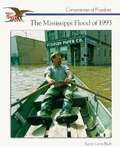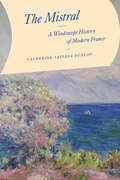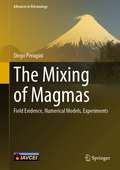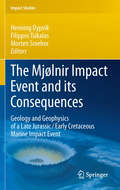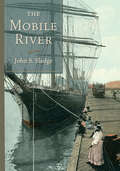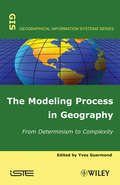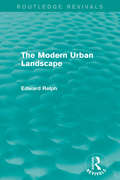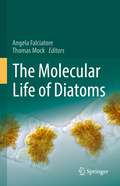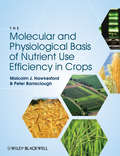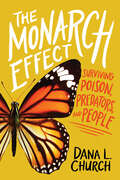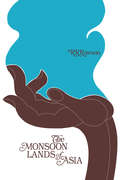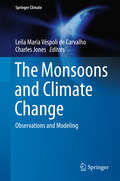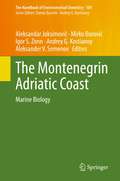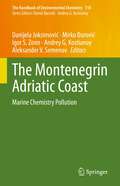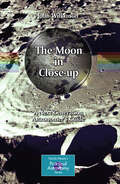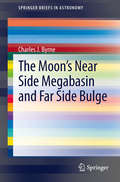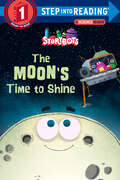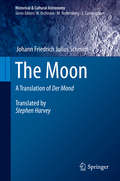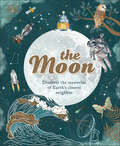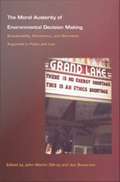- Table View
- List View
The Mississippi Flood of 1993 (Cornerstones of Freedom)
by Karin Luisa BadtTens of thousands of families in nine states across the Midwest were forced to abandon their homes that summer. The Mississippi River and its tributaries (the smaller rivers that flow into a large river) were swollen from months of rain.
The Mistral: A Windswept History of Modern France
by Catherine Tatiana DunlopAn in-depth look at the hidden power of the mistral wind and its effect on modern French history. Every year, the chilly mistral wind blows through the Rhône valley of southern France, across the Camargue wetlands, and into the Mediterranean Sea. Most forceful when winter turns to spring, the wind knocks over trees, sweeps trains off their tracks, and destroys crops. Yet the mistral turns the sky clear and blue, as it often appears in depictions of Provence. The legendary wind is central to the area’s regional identity and has inspired artists and writers near and far for centuries. This force of nature is the focus of Catherine Dunlop’s The Mistral, a wonderfully written examination of the power of the mistral wind, and in particular, the ways it challenged central tenets of nineteenth-century European society: order, mastery, and predictability. As Dunlop shows, while the modernizing state sought liberation from environmental realities through scientific advances, land modification, and other technological solutions, the wind blew on, literally crushing attempts at control, and becoming increasingly integral to regional feelings of place and community.
The Mixing of Magmas: Field Evidence, Numerical Models, Experiments (Advances in Volcanology)
by Diego PeruginiThis book provides a common theoretical and practical basis to the multifaceted nature of magma mixing. This process represents a fundamental phenomenon both in the evolution of igneous rocks and in triggering explosive volcanic eruptions. The topic is attacked surgically merging field evidence, numerical models, and experiments in order to draw the most complete picture about this natural process. Arguments are discussed in the light of Chaos Theory and Fractal Geometry as new tools to understand the role of magma mixing as a fundamental petrological and volcanological process. The book is intended to be a source of information and a stimulus for new ideas in students, young and possibly more experienced researches.
The Mjølnir Impact Event and its Consequences: Geology and Geophysics of a Late Jurassic/Early Cretaceous Marine Impact Event (Impact Studies)
by Morten Smelror Henning Dypvik Filippos TsikalasThe Mjølnir impact structure was recognized in 1993 and included in the Earth Impact Database in 1996, based on the discoveries of unequivocal meteorite impact indicators such as shocked quartz, Ir-enrichments, possible glass remnants, fragments of nickel-rich iron oxides, in addition to the convincing complex crater shape of the structure. This book presents the geological and geophysical history of the Barents Sea region along with the discovery of the Mjølnir impact crater. We place the Mjølnir event into the geological framework of the region and present elaborative numerical models of its formation and associated tsunami generation. The book represents an update and synthesis as well as the complete compilation of the Mjølnir crater studies.
The Mobile River
by John S. Sledge“A fine, fascinating book. John S. Sledge introduces us to four centuries worth of heroes and rogues on one incredible American river.” —Winston Groom, New York Times–bestselling author of Forrest GumpThe Mobile River presents the first-ever narrative history of this important American watercourse. Inspired by the venerable Rivers of America series, John S. Sledge weaves chronological and thematic elements with personal experiences and more than sixty color and black-and-white images for a rich and rewarding read.Previous historians have paid copious attention to the other rivers that make up the Mobile’s basin, but the namesake stream along with its majestic delta and beautiful bay have been strangely neglected. In an attempt to redress the imbalance, Sledge launches this book with a first-person river tour by “haul-ass boat.” Along the way he highlights the four diverse personalities of this short stream—upland hardwood forest, upper swamp, lower swamp, and harbor.In the historical saga that follows, readers learn about colonial forts, international treaties, bloody massacres, and thundering naval battles, as well as what the Mobile River’s inhabitants ate and how they dressed through time. A barge load of colorful characters is introduced, including Native American warriors, French diplomats, British cartographers, Spanish tavern keepers, Creole women, steamboat captains, African slaves, Civil War generals and admirals, Apache prisoners, hydraulic engineers, stevedores, banana importers, Rosie Riveters, and even a few river rats subsisting off the grid—all of them actors in a uniquely American pageant of conflict, struggle, and endless opportunity along a river that gave a city its name.“Sledge brilliantly explores the myriad ways human history has entwined with the Mobile River.” —Gregory A. Waselkov, author of A Conquering Spirit
The Mobilities of Ships
by Anyaa Anim-Addo, William Hasty and Kimberley PetersWe live in a world that is ever on the move, as is increasingly recognised within research on mobilities. Yet studies of mobility have failed to ‘go to sea’ with the same enthusiasm as mobilities ashore. When we consider mobility, we most often examine those movements that evidently form part of our everyday lives. We forget to look outwards to the sea. Yet ships have played – and continue to play – a significant role in shaping socio-cultural, political and economic life. This book turns our attention to the manifold mobilities that occur at sea through an exploration of the mobilities of ships themselves as well as the movements of objects, subjects and ideas that are mobilised by ships. The Mobilities of Ships brings together seven chapters that tack through unexplored waters and move between diverse case studies, including pirate ships, naval vessels and luxury yachts. In so doing, The Mobilities of Ships offers a rich insight into the world of shipping mobilities past and present.This book was published as a special issue of Mobilities.
The Modeling Process in Geography: From Determinism to Complexity
by Yves GuermondThis title focuses on the evolution of the modeling process and on new research perspectives in theoretical and applied geography, as well as spatial planning. In the last 50 years, the achievements of spatial analysis models opened the way to a new understanding of the relationship between society and geographical space. In this book, these models are confronted by the real conditions of territorial prospect, regional dynamism, cultural policy, HMO, and spatial segregation. This confrontation takes into account the instability of social behavior and the permanence of partial determinist trajectories.
The Modelling of Radiation Damage in Metals Using Ehrenfest Dynamics
by Christopher RaceAtomistic simulations of metals under irradiation are indispensable for understanding damage processes at time- and length-scales beyond the reach of experiment. Previously, such simulations have largely ignored the effect of electronic excitations on the atomic dynamics, even though energy exchange between atoms and electrons can have significant effects on the extent and nature of radiation damage. This thesis presents the results of time-dependent tight-binding simulations of radiation damage, in which the evolution of a coupled system of energetic classical ions and quantum mechanical electrons is correctly described. The effects of electronic excitations in collision cascades and ion channeling are explored and a new model is presented, which makes possible the accurate reproduction of non-adiabatic electronic forces in large-scale classical molecular dynamics simulations of metals.
The Modern Urban Landscape (Routledge Revivals)
by Edward RelphFirst published in 1987, this book provides a wide-ranging account of how modern cities have come to look as they do — differing radically from their predecessors in their scale, style, details and meanings. It uses many illustrations and examples to explore the origins and development of specific landscape features. More generally it traces the interconnected changes which have occurred in architecture and aesthetic fashions, in planning, in economic and social conditions, and which together have created the landscape that now prevails in most of the cities of the world. This book will be of interest to students of architecture, urban studies and geography.
The Molecular Life of Diatoms
by Angela Falciatore Thomas MockDiatoms are the most species rich group of algae, and they contribute about 20% of annual global carbon fixation. They play major roles in ocean food webs and global biogeochemical cycles. They are also a target of the biotechnology industry because of their nano-patterned silica cell wall and high lipid content. Diatoms have received increasing attention as more genomes became available and because of the development of genome editing tools such as the CRISPR/Cas9 technology, which has made diatoms as genetically tractable as well-established biological model species. This book provides an overview on diatom molecular biology. It brings together international leading experts in the field to discuss the latest data and developments from genes to ecosystems. As the understanding of diatoms is currently experiencing a step change, it is critical to allow for synergistic approaches on diverse aspects of diatom biology and evolution. The books offers fundamental insights into the molecular life of diatoms; at the same time new scientific concepts are developed based on the application of the latest molecular tools and genomic information to explore the fascinating lifestyle of diatoms.
The Molecular and Physiological Basis of Nutrient Use Efficiency in Crops
by Malcolm J. Hawkesford Peter BarracloughEfforts to increase efficient nutrient use by crops are of growing importance as the global demand for food, fibre and fuel increases and competition for resources intensifies. The Molecular and Physiological Basis of Nutrient Use Efficiency in Crops provides both a timely summary of the latest advances in the field as well as anticipating directions for future research. The Molecular and Physiological Basis of Nutrient Use Efficiency in Crops bridges the gap between agronomic practice and molecular biology by linking underpinning molecular mechanisms to the physiological and agronomic aspects of crop yield. These chapters provide an understanding of molecular and physiological mechanisms that will allow researchers to continue to target and improve complex traits for crop improvement.Written by leading international researchers, The Molecular and Physiological Basis of Nutrient Use Efficiency in Crops will be an essential resource for the crop science community for years to come.Special Features:coalesces current knowledge in the areas of efficient acquisition and utilization of nutrients by crop plants with emphasis on modern developments addresses future directions in crop nutrition in the light of changing climate patterns including temperature and water availability bridges the gap between traditional agronomy and molecular biology with focus on underpinning molecular mechanisms and their effects on crop yield includes contributions from a leading team of global experts in both research and practical settings
The Monarch Effect: Surviving Poison, Predators, and People (Scholastic Focus)
by Dana L. ChurchA not-so-typical look at the mysteries of the monarch butterflyScholastic Focus is the premier home of thoroughly researched, beautifully written, and thoughtfully designed works of narrative nonfiction aimed at middle-grade and young adult readers. These books help readers learn about the world in which they live and develop their critical thinking skills so that they may become dynamic citizens who are able to analyze and understand our past, participate in essential discussions about our present, and work to grow and build our future.With their stunning black-and-orange wings, monarch butterflies are one of the most recognizable insects on the planet. But despite their delicate beauty, these creatures are warriors. The moment they hatch, they're fighting for their lives. Everything is the enemy: from the very leaf they live on to the humans and animals around them to nature itself. How does such a tiny egg survive to become a butterfly? And even after emerging from the cocoon, unimaginable danger awaits: migration.Every year, monarchs take flight, making one of the greatest migrations in the world. However, for a long time, their destination was unknown within the scientific community. Through the research of scientists in Canada and the United States and the support and efforts of ordinary people as well as Indigenous knowledge in Mexico, that mystery was finally solved. But to do so would involve years of searching across three countries and encounters with feuding scientists, the consequences of colonialism, and life-and-death stakes. Weaving together the untold story of survival, scientific discoveries, and the relationship between humans and butterflies, The Monarch Effect explores how one small insect can have an incredible impact on the entire planet.
The Monsoon Lands of Asia
by Gadi BenEzerAccording to the author a geographic region must satisfy the following conditions: however striking the diversity of the physical setting and the languages, religions and general appearance of the people, there must be some aspect of culture (for example, the social outlook or the organization of the economy) which pervades the area in such a way as to justify the recognition and study of that area as one entity and there must be substantial cultural differences between it and adjacent areas.Monsoon Asia, from Pakistan to Japan is more than a land area and an assemblage of countries: it is a distinctive geographical region. Its population--which includes nearly half the people in the world--is mainly rural, its economy mainly agricultural, and its peoples share a heritage of material poverty. But change is apparent everywhere in the area. This book is a compact and lucid introduction to the dynamic as well as the unchanging characteristics of the region.After an introductory section, which defines the limits of Monsoon Asia, there follow chapters on structure and relief, climate, vegetation, and soils. A discussion of the historical geography of the region leads into studies of its agriculture and industry. The concluding two-thirds of the book survey the characteristics of the constituent countries--India, Pakistan, Ceylon, China, Japan, Korea, and South-East Asia proper (Burma, Malaya, Thailand, Indonesia, the Philippines, etc.).Special attention is paid throughout to the political and social setting of current political problems. The book contains 17 plates, 48 maps and diagrams, a selected bibliography, and an index.
The Monsoons and Climate Change
by Charles Jones Leila Maria Véspoli CarvalhoThis book presents a global overview examining monsoon variability in South Asia, Australian, South America and North American, as well as a focus on glaciers and monsoon systems. Monsoon systems are important components of the Earth's climate and play fundamental roles in water and energy balances. The variability and changes in the monsoons affect millions of people and the economies of many countries. This book presents the physical mechanisms involved with monsoon systems, including recent modeling advances addressing climate changes and future projections. The Monsoons and Climate Change will be of interest to both graduate students and researchers.
The Montenegrin Adriatic Coast
by Andrey G. Kostianoy Igor S. Zonn Aleksandar Joksimović Aleksander V. Semenov Mirko ĐurovićThis is the first of two volumes that together provide an integrated picture of the Montenegrin Adriatic coast, presenting the natural components of the system as well as the chemical composition and chemical processes in the extended area. <P><P> This book describes the biology and ecology of the high seas of the Montenegrin coast, with a special focus on their biodiversity, flora and fauna, fisheries, mariculture, marine reptiles and mammals. The data has been collected through national and international projects over the last few decades and provides the reader with models and recommendations for the protection of this vital region of the Adriatic coast, as well as scientific recommendations for the sustainable use of its biological resources. <P><P> Given the breadth and depth of its coverage, the book offers an invaluable source of information for researchers, students and environmental managers alike.
The Montenegrin Adriatic Coast: Marine Chemistry Pollution (The Handbook of Environmental Chemistry #110)
by Andrey G. Kostianoy Igor S. Zonn Aleksander V. Semenov Mirko Đurović Danijela JoksimovićThis is the second of two volumes that together provide an integrated picture of the Montenegrin Adriatic coast, presenting the natural components of the system as well as the chemical composition and chemical processes in the extended area. This book covers all aspects of marine chemistry such as the hydrographic and oceanographic characteristics of seawater, the toxicity of heavy metals in the marine environment, the quality of marinas and maritime areas, and the legal regime for protecting the marine environment from pollution. Given the breadth and depth of its coverage, the book offers an invaluable source of information for researchers, students and environmental managers alike.
The Moon Seems to Change (Let's-Read-and-Find-Out Science 2)
by Dr. Franklyn M. BranleyRead and find out about the phases of the moon in this colorfully illustrated nonfiction picture book.This clear and appealing science book for early elementary age kids, both at home and in the classroom, introduces basic information about the moon.Have you noticed that the moon sometimes seems to grow and shrink? Does it look like a big round ball? Or is it just a sliver of light in the sky? The moon seems to change. But it doesn't really. The moon revolves around the Earth. It takes about four weeks to make the journey, and as it travels around we can only see certain parts of it. Try the simple experiment described inside using an orange, a pencil, and a flashlight, and you'll understand why the moon seems to change.This is a Level 2 Let's-Read-and-Find-Out, which means the book explores more challenging concepts for children in the primary grades. The 100+ titles in this leading nonfiction series are:hands-on and visualacclaimed and trustedgreat for classroomsTop 10 reasons to love LRFOs:Entertain and educate at the same timeHave appealing, child-centered topicsDevelopmentally appropriate for emerging readersFocused; answering questions instead of using survey approachEmploy engaging picture book quality illustrationsUse simple charts and graphics to improve visual literacy skillsFeature hands-on activities to engage young scientistsMeet national science education standardsWritten/illustrated by award-winning authors/illustrators & vetted by an expert in the fieldOver 130 titles in print, meeting a wide range of kids' scientific interestsBooks in this series support the Common Core Learning Standards, Next Generation Science Standards, and the Science, Technology, Engineering, and Math (STEM) standards. Let's-Read-and-Find-Out is the winner of the American Association for the Advancement of Science/Subaru Science Books & Films Prize for Outstanding Science Series.
The Moon in Close-up
by John WilkinsonInformation collected by recent space probes sent to explore the Moon by the USA, the European Space Agency, Japan, China and India has changed our knowledge and understanding of the Moon, particularly its geology, since the Apollo missions. This book presents those findings in a way that will be welcomed by amateur astronomers, students, educators and anyone interested in the Moon. Enhanced by many colour photos, it combines newly acquired scientific understanding with detailed descriptions and labelled photographic maps of the lunar surface. Guided by observation methods explained in the book and 17 Study Areas presented and carefully explained in the last chapter, amateur astronomers can observe these features from Earth using telescopes and binoculars. Readers who consult the photographic maps will gain a better understanding about the Moon's topography and geology. The book is rounded out by a helpful glossary.
The Moon of the Wild Pigs (Thirteen Moons)
by Jean Craighead GeorgeDescribes animal and plant life in the drought-parched desert during the month of July and how a little wild pig adapts to this environment. Includes image descriptions.
The Moon's Near Side Megabasin and Far Side Bulge
by Charles ByrneSince Luna and Lunar Orbiter photographed the far side of the Moon, the mysterious dichotomy between the face of the Moon as we see it from Earth and the side of the Moon that is hidden has puzzled lunar scientists. As we learned more from the Apollo sample return missions and later robotic satellites, the puzzle literally deepened, showing asymmetry of the crust and mantle, all the way to the core of the Moon. This book summarizes the author's successful search for an ancient impact feature, the Near Side Megabasin of the Moon and the extensions to impact theory needed to find it. The implications of this ancient event are developed to answer many of the questions about the history of the Moon.
The Moon's Time to Shine (Step into Reading)
by StorybotsJust in time for the 50th anniversary of the moon landing! The inquisitive crew from the award-winning StoryBots apps, videos, and Emmy Award-winning Netflix show star in a Step 1 reader that is over the moon!Children will recognize the signature catchy rhymes and colorful art from the StoryBots' popular YouTube video "The Moon's Time to Shine." They will learn that the moon orbits Earth, that--in spite of glowing brightly--it doesn't make its own light, and more! Step 1 readers feature big type and easy words for children who know the alphabet and are eager to begin reading. Rhyming text is paired with picture clues to help children decode the story.
The Moon: A Translation of Der Mond (Historical & Cultural Astronomy)
by Johann Friedrich SchmidtJulius Schmidt was one of the finest astronomical observers of his time, and his detailed map of the Moon surpassed anything that had come before. Today, the German astronomer and geophysicist has remained a largely neglected figure, despite being one of the most important players in the history of lunar studies. This book at last makes accessible Schmidt’s highly regarded German work, Der Mond. Considered an astronomical classic of the nineteenth century, Der Mond remained without a proper English counterpart for the last century and a half, until now. The author’s faithful English translation provides readers with much-needed access into Schmidt’s original publication, with the aim of showing the community just how vital his work and legacy have been in the international field of selenography.
The Moon: Discover the Mysteries of Earth's Closest Neighbour (Space Explorers)
by Dr. Sanlyn Buxner Pamela Gay Georgiana KramerDiscover the mysteries of Earth&’s closest neighbor in this incredible guide to the Moon. This charming book is the perfect introduction for young readers who want to learn about every aspect of the moon. The Moon features breakdowns of the Moon&’s formation and geography, the lunar phases, a history of NASA&’s Apollo missions, the Moon&’s effect on Earth&’s tides and nocturnal animals, recent scientific discoveries, and so much more!This fascinating guide introduces 7-9 year olds to the moon&’s past, present, and future, through stunning illustrations, photographs, and fascinating information. Packed with mind-blowing facts, this incredible book of the moon is perfect for space lovers everywhere. Explore this wonderful book about the moon, featuring:- In-depth information, backed up by space photography, probe images, illustrations, and fun diagrams- Stunning, dreamy illustrations, making this title a perfect gift, as well as a solid reference book - Easy-to-digest sections, each filled with incredible facts and visuals- The entire subject of the Moon – including its formation and geography, the lunar phases, a history of NASA&’s Apollo missions, its effect on Earth&’s tides and nocturnal animals, plenty of recent scientific discoveries, and more!Boasting beautiful illustrations by artist Dawn Cooper, combined with up-to-date images from space agencies such as NASA and ESA, info panels, timelines, and diagrams, that help demystify and explain the wonder of the Moon, this is the perfect book for young readers.
The Moral Austerity of Environmental Decision Making: Sustainability, Democracy, and Normative Argument in Policy and Law
by John Martin Gillroy Joe BowersoxIn The Moral Austerity of Environmental Decision Making a group of prominent environmental ethicists, policy analysts, political theorists, and legal experts challenges the dominating influence of market principles and assumptions on the formulation of environmental policy. Emphasizing the concept of sustainability and the centrality of moral deliberation to democracy, they examine the possibilities for a wider variety of moral principles to play an active role in defining "good" environmental decisions. If environmental policy is to be responsible to humanity and to nature in the twenty-first century, they argue, it is imperative that the discourse acknowledge and integrate additional normative assumptions and principles other than those endorsed by the market paradigm. The contributors search for these assumptions and principles in short arguments and debates over the role of science, social justice, instrumental value, and intrinsic value in contemporary environmental policy. In their discussion of moral alternatives to enrich environmental decision making and in their search for a less austere and more robust role for normative discourse in practical policy making, they analyze a series of original case studies that deal with environmental sustainability and natural resources policy including pollution, land use, environmental law, globalism, and public lands. The unique structure of the book--which features the core contributors responding in a discourse format to the central chapters' essays and debates--helps to highlight the role personal and public values play in democratic decision making generally and in the field of environmental politics specifically. Contributors. Joe Bowersox, David Brower, Susan Buck, Celia Campbell-Mohn, John Martin Gillroy, Joel Kassiola, Jan Laitos, William Lowry, Bryan Norton, Robert Paehlke, Barry G. Rabe, Mark Sagoff, Anna K. Schwab, Bob Pepperman Taylor, Jonathan Wiener
The Moral Challenge of Dangerous Climate Change
by Darrel MoellendorfThis book examines the threat that climate change poses to the projects of poverty eradication, sustainable development, and biodiversity preservation. It offers a careful discussion of the values that support these projects and a critical evaluation of the normative bases of climate change policy. This book regards climate change policy as a public problem that normative philosophy can shed light on. It assumes that the development of policy should be based on values regarding what is important to respect, preserve, and protect. What sort of climate change policy do we owe the poor of the world who are particularly vulnerable to climate change? Why should our generation take on the burden of mitigating climate change that is caused, in no small part, by emissions from people now dead? What value is lost when natural species go extinct, as they may well do en masse because of climate change? This book presents a broad and inclusive discussion of climate change policy, relevant to those with interests in public policy, development studies, environmental studies, political theory, and moral and political philosophy.
